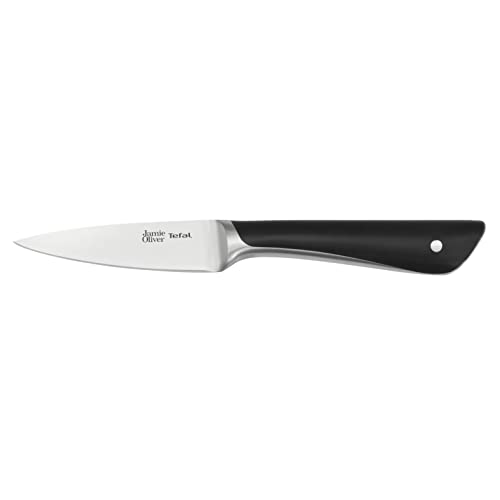The Serrated Edge on a Paring Knife: What is it Used For?
When it comes to kitchen knives, the paring knife is an essential tool for any chef or home cook. Its small size and versatile blade make it perfect for tasks like peeling, trimming, and slicing fruits and vegetables. Most paring knives have a straight edge, but some also feature a serrated edge. In this article, we will explore the uses of a serrated edge on a paring knife and why it might be a valuable addition to your kitchen arsenal.
What is a serrated edge?
A serrated edge, also known as a scalloped edge or toothed edge, is characterized by a row of small, jagged teeth along the blade. These teeth create small points of contact with the food, allowing for a more aggressive and controlled cutting action. Unlike a straight edge, which relies on a sharp, smooth surface to slice through ingredients, a serrated edge can grip and penetrate foods with tough exteriors or soft interiors.
Why choose a paring knife with a serrated edge?
While a straight-edged paring knife can handle many tasks, a serrated edge offers distinct advantages in certain situations. Here are some reasons why you might choose a paring knife with a serrated edge:
- Bread and delicate slicing: A serrated edge is ideal for slicing through delicate ingredients, such as ripe tomatoes or soft-skinned fruits, without squashing or tearing them. It can also be used for slicing bread without crushing the loaf.
- Hard-shelled fruits and vegetables: When dealing with tough-skinned produce like pineapples, melons, or winter squash, a serrated edge makes it easier to cut through the hard exterior while keeping the soft insides intact.
- Peeling: The serrated edge can provide extra grip and control when peeling fruits and vegetables with slippery or waxy surfaces, ensuring a precise and efficient peel.
- Deveining shrimp: The serrated edge can make quick work of deveining shrimp, allowing you to remove the gritty digestive tract without damaging the delicate meat.
- Knife longevity: The serrated edge tends to retain its sharpness for a longer time compared to a straight edge, as the points of contact with the food are distributed along the teeth. This can reduce the frequency of sharpening or honing.
How to maintain a serrated edge paring knife?
Proper maintenance is essential for preserving the performance and lifespan of any kitchen knife, including those with serrated edges. Here are some tips for maintaining a paring knife with a serrated edge:
- Handwashing: It is recommended to wash your serrated edge paring knife by hand, using warm water and mild dish soap. Avoid putting it in the dishwasher, as the high heat and harsh detergents can damage both the blade and the handle.
- Drying: After washing, make sure to thoroughly dry the knife with a clean towel to prevent moisture buildup, which can lead to rust or corrosion.
- Proper storage: Store your serrated edge paring knife in a knife block, a knife sheath, or on a magnetic strip to protect the blade and prevent accidents.
- Regular honing: While a serrated edge does not require frequent sharpening, regular honing can help maintain its performance. Use a serrated knife sharpener or a honing rod specifically designed for serrated edges to realign the teeth and keep them sharp.
- Professional sharpening: If the serrated edge becomes dull or damaged, it is best to seek professional sharpening services. Sharpening serrated knives can be challenging to do at home without the proper tools and experience.
How to choose the right serrated edge paring knife?
When selecting a paring knife with a serrated edge, there are a few factors to consider:
- Blade length: Paring knives come in various blade lengths, typically ranging between 2.5 to 4 inches. Choose a length that feels comfortable and suits your cutting style.
- Handle material: Look for a handle material that provides a secure grip and is comfortable to hold for extended periods.
- Blade material and construction: High-quality stainless steel or carbon steel blades are commonly used in paring knives. Consider the blade material and construction for durability and performance.
- Brand reputation: Research reputable knife brands known for their craftsmanship and quality to ensure you are getting a reliable product.
Other uses for a serrated edge paring knife
While the primary purpose of a serrated edge paring knife is for slicing and peeling, it can also be used for various other tasks in the kitchen. These include:
- Segmenting citrus: The serrated edge helps cut through the membranes of citrus fruits, making it easier to separate the segments.
- Trimming fat: The serrated edge can be effective in trimming excess fat from meat without applying excessive force.
- Removing corn kernels: When preparing fresh corn, a serrated edge paring knife can quickly and cleanly remove the kernels from the cob.
- Garnishing: The serrated edge can create decorative cuts on fruits and vegetables for garnishing or plating purposes.
In conclusion, a serrated edge on a paring knife provides added versatility, especially for tasks that require precision and control. It excels in situations where a straight edge may struggle, such as slicing delicate produce or dealing with tough exteriors. By understanding its uses and properly maintaining it, a serrated edge paring knife can be a valuable tool in the kitchen, making your cooking experience easier and more enjoyable.






